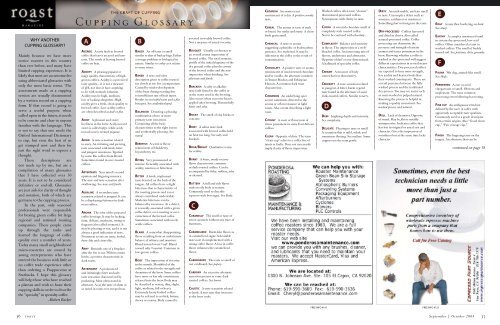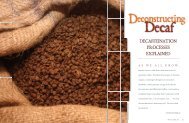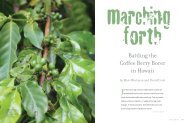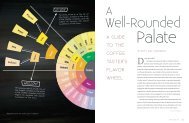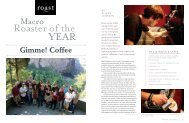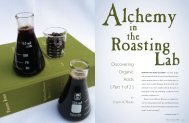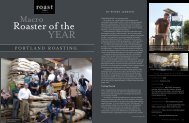Craft of Cupping - Roast Magazine
Craft of Cupping - Roast Magazine
Craft of Cupping - Roast Magazine
You also want an ePaper? Increase the reach of your titles
YUMPU automatically turns print PDFs into web optimized ePapers that Google loves.
Why ANOTheR<br />
CUPPING GlOssARy?<br />
Mainly because we have more<br />
novice roasters in this country<br />
than ever before, and many have<br />
limited cupping experience. It is<br />
likely that most are accustomed to<br />
using abbreviated glossaries with<br />
only the most basic terms. The<br />
assessments made at a cupping<br />
session are usually documented<br />
by a written record on a cupping<br />
form. If that record is going to<br />
serve a useful purpose when<br />
called upon in the future, it needs<br />
to be concise and clear to anyone<br />
familiar with the language. This<br />
is not to say that one needs the<br />
Oxford International Dictionary<br />
to cup, but even the best <strong>of</strong> us<br />
get stumped now and then for<br />
just the right word to express a<br />
thought.<br />
These descriptions are<br />
not made up by me, but are a<br />
compilation <strong>of</strong> many glossaries<br />
that I have collected over 30<br />
years. It is not to be considered<br />
definitive or end-all. Glossaries<br />
are just aids for clarity <strong>of</strong> thought<br />
and notation, both <strong>of</strong> which are<br />
germane to the cupping process.<br />
In the past, only seasoned<br />
pr<strong>of</strong>essionals were responsible<br />
for buying green c<strong>of</strong>fee for large<br />
regional and national roasting<br />
companies. These people came<br />
up through the ranks and<br />
learned the language <strong>of</strong> c<strong>of</strong>fee<br />
quality over a number <strong>of</strong> years.<br />
Today many small neighborhood<br />
micro-roasteries are owned by<br />
young entrepreneurs who have<br />
entered the business with little or<br />
no c<strong>of</strong>fee trade experience other<br />
than ordering a Frappuccino at<br />
Starbucks. I hope this glossary<br />
will help those who have reached<br />
a plateau and wish to hone their<br />
cupping skills in order to describe<br />
the “specialty” in specialty c<strong>of</strong>fee.<br />
–Robert Barker<br />
A<br />
Ac e r B i c A taste fault in brewed<br />
c<strong>of</strong>fee that leaves an acrid and sour<br />
taste. The result <strong>of</strong> leaving brewed<br />
c<strong>of</strong>fee on heat.<br />
AciDiTy A pleasing piquant or<br />
tangy quality characteristic <strong>of</strong> highgrown<br />
c<strong>of</strong>fees. Acidity is a perceived<br />
taste quality—it is not a measure<br />
<strong>of</strong> pH, nor does it have anything<br />
to do with stomach irritation.<br />
Acidity may be high, medium,<br />
low or lacking altogether. High<br />
acidity gives a fresh, clean quality to<br />
brewed c<strong>of</strong>fee. Low acidity c<strong>of</strong>fees<br />
are <strong>of</strong>ten described as dull or flat.<br />
Ac iD y A pleasant and sweet<br />
liveliness in the brew. Acidy toward<br />
sweet is called nippy, while acidy<br />
toward sour is termed piquant.<br />
Ac r i D A taste sensation related<br />
to soury. An irritating and piercing<br />
taste associated with harsh, bitter<br />
and pungent sensations. Typified<br />
by some Rio c<strong>of</strong>fees from Brazil.<br />
Sometimes found in over-roasted<br />
c<strong>of</strong>fees.<br />
AF T e r TA s T e Your mind’s second<br />
opinion and lingering memory.<br />
The nose and taste sensation after<br />
swallowing. See nose and finish.<br />
Al k A l i n e A secondary taste<br />
sensation related to pungent. It can<br />
be a displeasing bitterness in darkroast<br />
c<strong>of</strong>fees.<br />
Ar o m A The odor <strong>of</strong> the prepared<br />
c<strong>of</strong>fee beverage. It may be lacking,<br />
faint, delicate, moderate, strong or<br />
fragrant (also called aromatic). It<br />
may be pleasing or not, and it is not<br />
always a good indication <strong>of</strong> taste.<br />
Prominent scents are nutty, herbal,<br />
berry-like and citrus-like.<br />
As h y Reminds one <strong>of</strong> a fireplace<br />
after the fire is out. Within certain<br />
limits, a positive characteristic in<br />
dark roasts.<br />
As T r i n g e n T A pronounced<br />
and irritatingly bitter and salty<br />
taste sensation characterized by<br />
puckering. Most <strong>of</strong>ten noted in<br />
aftertaste. As in the taste <strong>of</strong> alum or<br />
as noted in some over-steeped teas.<br />
B<br />
BA g g y An <strong>of</strong>f-taste or smell<br />
similar to that <strong>of</strong> burlap bags. Either<br />
a storage problem or biological in<br />
nature. Similar to corky as it relates<br />
to some wines.<br />
BA k e D A taste and odor<br />
description given to c<strong>of</strong>fee roasted<br />
too slowly at too low a temperature.<br />
Caused by under-development<br />
<strong>of</strong> the bean during roasting due<br />
to insufficient rate <strong>of</strong> heat input.<br />
Results in an insipid taste and a flat<br />
bouquet. See underdeveloped.<br />
BA l A n c e D Denoting a pleasing<br />
combination <strong>of</strong> two or more<br />
primary taste sensations.<br />
Containing all the basic<br />
characteristics to the right extent<br />
and aesthetically pleasing. See<br />
round.<br />
Be r r y i s h A scent or flavor<br />
reminiscent <strong>of</strong> blackberry,<br />
boysenberry, etc.<br />
BiTing Very pronounced or<br />
intense. Generally associated with<br />
acidity, sourness or bitterness.<br />
Bi T T e r A harsh, unpleasant<br />
taste detected on the back <strong>of</strong> the<br />
tongue. All c<strong>of</strong>fees have a slight<br />
bitterness that is characteristic <strong>of</strong><br />
the roasting process and is not<br />
always considered undesirable.<br />
Moderate bitterness can be<br />
balanced by sweetness. As a defect,<br />
it is usually associated with a green<br />
c<strong>of</strong>fee defect, over-roasting or overextraction<br />
<strong>of</strong> the brewed c<strong>of</strong>fee.<br />
Sometimes associated with overly<br />
acidic c<strong>of</strong>fees.<br />
Bl A n D A somewhat disappointing<br />
flavor resulting from an unfortunate<br />
balance <strong>of</strong> saltiness and sweetness.<br />
Bland toward sweet=s<strong>of</strong>t. Bland<br />
toward salty=neutral. Common in<br />
low-grown c<strong>of</strong>fees.<br />
Bo D y The impression <strong>of</strong> viscosity<br />
in the mouth. Mouthfeel <strong>of</strong> the<br />
c<strong>of</strong>fee as related to the strength and<br />
chemistry <strong>of</strong> the brew. Some c<strong>of</strong>fees<br />
have more or less oily constituents<br />
released into the brew. Body may<br />
be described as watery, thin, slight,<br />
light, medium, full or heavy.<br />
Extremely heavy-bodied c<strong>of</strong>fees<br />
may be referred to as thick, buttery,<br />
chewy or creamy. Body cannot be<br />
assessed in weakly brewed c<strong>of</strong>fee.<br />
Not a measure <strong>of</strong> actual viscosity.<br />
Bo u q u e T Usually a reference to<br />
an overall aroma impression <strong>of</strong><br />
brewed c<strong>of</strong>fee. The total aromatic<br />
pr<strong>of</strong>ile <strong>of</strong> the initial fragrance <strong>of</strong> the<br />
dry ground c<strong>of</strong>fee plus the aroma<br />
<strong>of</strong> the brewed c<strong>of</strong>fee and the nose<br />
impression when drinking. See<br />
aftertaste and finish.<br />
Br A c k i s h A salty or alkaline<br />
taste fault found in the c<strong>of</strong>fee or<br />
in the water used in the brewing.<br />
Also occurs when excessive heat is<br />
applied after brewing. Distastefully<br />
bitter and salty.<br />
Br i c k y The smell <strong>of</strong> clay bricks or<br />
concrete.<br />
Br i n y A saline taste fault<br />
associated with brewed c<strong>of</strong>fee held<br />
on heat too long. See salty and<br />
brackish.<br />
Br i s k/Br i g h T Qualitative terms<br />
for acidity.<br />
Bu r n T A bitter, smoky or tarry<br />
flavor characteristic common<br />
in dark-roasted c<strong>of</strong>fees. Can be<br />
accompanied by fishy, rubbery, ashy<br />
or charred.<br />
Bu T T e r y A full and rich flavor<br />
with an oily body or texture.<br />
Commonly used to describe<br />
espresso-style beverages. See Body.<br />
C<br />
cA r A m e l ly The smell or taste <strong>of</strong><br />
sweet caramels without any trace <strong>of</strong><br />
burntness.<br />
cA r A m e l i z e D Burnt-like flavor, as<br />
in caramelized sugar. A desirable<br />
taste note if complemented with a<br />
strong c<strong>of</strong>fee flavor. A loss in c<strong>of</strong>fee<br />
flavor enhances the caramelized<br />
flavor.<br />
cA r D B o A r D y The taste or smell <strong>of</strong><br />
wet cardboard. See papery.<br />
cA r B o n y An excessive aftertaste<br />
sensation present in some dark<br />
roasted c<strong>of</strong>fees. See burnt.<br />
cA u s T i c A taste sensation related<br />
to harsh. A sour taste that increases<br />
as the brew cools.<br />
ce D A r i s h An aroma scent<br />
reminiscent <strong>of</strong> cedar. A positive woody<br />
taste.<br />
ce r e A l The aroma or taste <strong>of</strong> malt<br />
or bread. See malty and toasty. A clean<br />
fresh grain smell.<br />
ch e m i cA l A taste or aroma<br />
suggesting a phenolic or hydrocarbon<br />
presence. See medicinal. It may be<br />
inherent in the c<strong>of</strong>fee or the result <strong>of</strong><br />
contamination.<br />
ch o c o l AT y A positive taste or aroma<br />
reminiscent <strong>of</strong> unsweetened chocolate<br />
and/or vanilla. An aftertaste common<br />
in Yemen Mochas and Ethiopian<br />
Harrars. A common dark roast<br />
characteristic.<br />
ci n n A m o n An underlying spice<br />
accent sometimes detected in the<br />
aroma or a flavor nuance in light<br />
roasts. Also a term describing a light<br />
roast.<br />
ci T r u s y A scent or flavor note <strong>of</strong><br />
citrus prominent in some East African<br />
c<strong>of</strong>fees.<br />
cl e A n Opposite <strong>of</strong> dirty. The term<br />
“clean cup” refers to a c<strong>of</strong>fee free <strong>of</strong><br />
taints or faults. Does not necessarily<br />
imply clarity <strong>of</strong> flavor impression.<br />
Washed c<strong>of</strong>fees <strong>of</strong>ten taste “cleaner”<br />
than natural-processed c<strong>of</strong>fees.<br />
Synonymous with clarity in taste.<br />
co c o A A sweetish chocolate smell <strong>of</strong><br />
completely stale roasted c<strong>of</strong>fee.<br />
Not to be confused with chocolaty.<br />
co m P l e x iT y Balance and intensity<br />
in flavor. The impression <strong>of</strong> a wellblended<br />
c<strong>of</strong>fee. An interesting mix <strong>of</strong><br />
flavors, undertones and aftertastes.<br />
Opposite <strong>of</strong> dull or one-dimensional.<br />
A hallmark <strong>of</strong> specialty c<strong>of</strong>fee.<br />
cr e A m y A measure <strong>of</strong> body<br />
somewhat less than buttery.<br />
cr e o s o T y A taste sensation related<br />
to pungent. A bitter, burnt vegetal<br />
taste found in the aftertaste <strong>of</strong> some<br />
dark-roasted c<strong>of</strong>fees. Similar to tarry.<br />
36 roast September | October 2004 37<br />
D<br />
De e P Implying depth and intensity.<br />
See complexity.<br />
De l i cAT e Pleasing to taste or smell.<br />
A sensation that is mild, subtle and<br />
sometimes fleeting. See mellow. Some<br />
cuppers use the term gentle.<br />
Di r T y An undesirable, unclean smell<br />
or taste. Can imply a defect such as<br />
sourness, earthiness or mustiness.<br />
Something foul or foreign in the taste.<br />
Dr y-P r o c e s s e D C<strong>of</strong>fees harvested<br />
and dried in cherry. Also called<br />
natural-processed c<strong>of</strong>fee. C<strong>of</strong>fee<br />
processing can determine the<br />
presence and strength <strong>of</strong> certain<br />
aromas and tastes prominent in the<br />
brew. Knowing whether a c<strong>of</strong>fee is<br />
washed or dry-processed will suggest<br />
different expectations in several major<br />
characteristics. Dry-processed c<strong>of</strong>fees<br />
are expected to have more strength,<br />
less acidity and heavier body than<br />
their washed counterparts. There are<br />
several processes between the fully<br />
washed process and the traditional<br />
dry process. You may see terms such<br />
as semi-washed or pulped natural.<br />
Knowing the process is helpful in<br />
making a quality assessment. See<br />
washed process and natural.<br />
Du l l Lack <strong>of</strong> character. Opposite<br />
<strong>of</strong> round. May be flat or notably<br />
unimpressive. Indicates c<strong>of</strong>fee that<br />
has lost its original or usual zest and<br />
character. Gives the impression <strong>of</strong><br />
roundness but at the same time lacks<br />
character.<br />
FRee INFO #147 FRee INFO #123<br />
E<br />
eD g y A taste flaw bordering on hard.<br />
See sharp.<br />
eA r T h y A complex mustiness found<br />
in certain dry-processed, low-acid<br />
c<strong>of</strong>fees. Often considered a taint in<br />
washed c<strong>of</strong>fees. The smell <strong>of</strong> freshly<br />
turned soil. See potatoey, dirty, groundy.<br />
F<br />
FA u n A Wet dog, animal-like smell.<br />
See Hidy.<br />
Fe r m e n T e D A sour or acrid<br />
vinegar taste or smell. Obvious and<br />
unpleasant. The most common<br />
processing error following harvesting.<br />
Fi n e c u P An ambiguous term best<br />
defined by the user. A c<strong>of</strong>fee with<br />
apparently acceptable taste qualities.<br />
Commonly used as a grade descriptor<br />
from certain origins. Also “Good clean<br />
cup,” “Fair average cup.”<br />
Finish The lingering taste on the<br />
tongue. An aftertaste that can be<br />
continued on page 38


